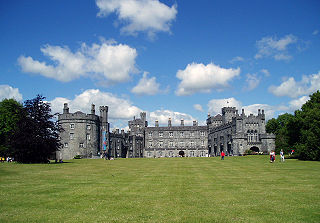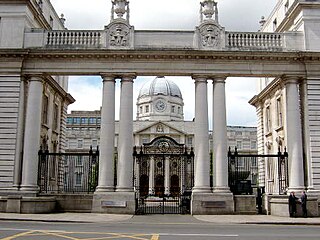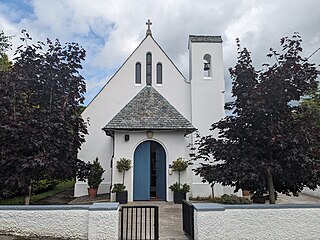
Merrion Square is a Georgian garden square on the southside of Dublin city centre.

Kilkenny Castle is a castle in Kilkenny, Ireland, built in 1260 to control a fording-point of the River Nore and the junction of several routeways. It was a symbol of Norman occupation, and in its original 13th-century condition, it would have formed an important element of the town's defences with four large circular corner towers and a massive ditch, part of which can still be seen today on the Parade.
Mount Merrion is a suburb of Dublin, Ireland. It is roughly 7 kilometres (5 mi) south of Dublin city centre and is situated on and around the hill of the same name.

Richard FitzWilliam, 5th Viscount FitzWilliam, PC (Ireland), of Mount Merrion in Dublin, was an Irish nobleman and Whig politician.

Viscount FitzWilliam, of Merrion in the County of Dublin, was a title in the Peerage of Ireland. It was created in 1629 for Thomas FitzWilliam, along with the subsidiary title Baron FitzWilliam, of Thorncastle in the County of Dublin, also in the Peerage of Ireland. He was succeeded by his son Oliver, the second Viscount. In 1661 Oliver was created Earl of Tyrconnell in the Peerage of Ireland. The earldom became extinct on his death in 1667, but he was succeeded in the barony and viscountcy by his younger brother William FitzWilliam, the third Viscount. William's grandson Richard, the fifth Viscount, represented Fowey in the British Parliament. His son Richard, the sixth Viscount, was a member of both the Irish and English Privy Councils. The seventh Viscount was a benefactor and musical antiquarian. The titles became extinct on the death of the ninth Viscount in 1833.

Merrion Street is a major Georgian street on the southside of Dublin, Ireland, which runs along one side of Merrion Square. It is divided into Merrion Street Lower, Merrion Square West and Merrion Street Upper. It holds one entrance to the seat of the Irish Parliament, the Oireachtas, major government offices and two major cultural institutions.

Baggot Street is a street in Dublin, Ireland.
Oliver FitzWilliam, 1st Earl of Tyrconnell and 2nd Viscount FitzWilliam, was an Irish nobleman.

Richard FitzWilliam, 7th Viscount FitzWilliam of Mount Merrion, Dublin, Ireland, and of FitzWilliam House in the parish of Richmond in Surrey, England, was an Anglo-Irish nobleman in the Peerage of Ireland who was a benefactor and musical antiquarian who founded the Fitzwilliam Museum in Cambridge, England, with a bequest of his library and art collection. He was also a significant urban developer in the City of Dublin. He served as a Member of Parliament for Wilton in Wiltshire, England, from 1790 until his death.

Fitzwilliam Square is a Georgian garden square in the south of central Dublin, Ireland. It was the last of the five Georgian squares in Dublin to be built, and is the smallest.

Kilteel is the name of a village, townland and civil parish located in the barony of South Salt, County Kildare, Ireland. The townland of Kilteel Upper contains the remains of a church with a decorated Romanesque chancel arch, the ruins of a 13th-century preceptory of the Knights Hospitaller and a well-preserved 15th-century tower house. The historic settlement is located on the southwest corner of the English Pale and served an important function as a border fortress during the medieval period.

Richard FitzWilliam, 6th Viscount FitzWilliam, KB, PC, FRS, of Mount Merrion, near Dublin, Ireland, was an Anglo-Irish peer and property developer.
James Cornwalsh was an Irish judge who held the office of Chief Baron of the Irish Exchequer. He was a political figure of considerable importance in fifteenth-century Ireland, and a supporter of the Lord Lieutenant of Ireland, James Butler, 4th Earl of Ormond. He was murdered as a result of a feud over the possession of Baggotrath Castle, near Dublin.

Baggotrath Castle, or Baggotsrath Castle, was a castle situated at present-day Baggot Street in Dublin city centre. It was built in the late thirteenth century by the Bagod family, for whom it was named. For much of its history, it was owned by the Fitzwilliam family.
Sir Robert Bagod was an Irish judge who was appointed the first Chief Justice of the Irish Common Pleas in 1276. He built Baggotrath Castle, which was the strongest fortress in Dublin: it was located on present-day Baggot Street in central Dublin. He also founded the Carmelite Friary in Dublin.
Thomas FitzWilliam, 1st Viscount Fitzwilliam (1581–1650) was an Irish nobleman of the Stuart age. He was born to wealth and privilege, and acquired a peerage, but due to his loyalty to the English Crown, he suffered considerable hardship during the English Civil War, and died in poverty.
William FitzWilliam, 3rd Viscount FitzWilliam (c.1610–1674) was an Irish nobleman of the Stuart era. He fought on the Royalist side during the English Civil War, but later made his peace with the Cromwellian regime. In his later years, he openly professed the Roman Catholic faith, which was then illegal.
Thomas FitzWilliam, 4th Viscount FitzWilliam (c.1640–1704) was an Irish nobleman and statesman; he was a leading Irish Jacobite, and a political figure of some importance during the Williamite War in Ireland.
James Fitzwilliam was an Irish landowner and judge who held the office of Chief Baron of the Irish Exchequer. He was the ancestor of the prominent Dublin landowning family which acquired the titles Viscount FitzWilliam and Earl of Tyrconnell.
Sir John Cruys or Cruise was a prominent Irish military commander, diplomat and judge of the late fourteenth and early fifteenth centuries. He was one of the most substantial landowners in County Dublin and County Meath and built Merrion Castle near Dublin City in the 1360s. His marriage to the heiress of the powerful Verdon family of Clonmore brought him in addition substantial lands in County Louth. He sat in the Irish Parliament and was a member of the King's Council. He was a highly regarded public servant, but also a determined and acquisitive man of business, who fought a ten-year battle to establish his wife's right to her inheritance.












